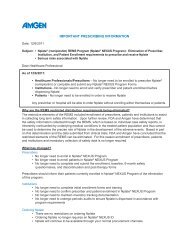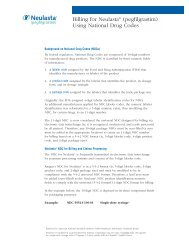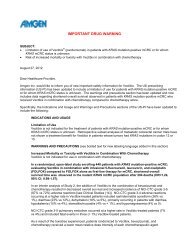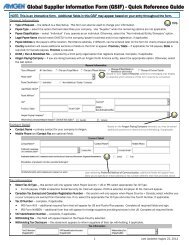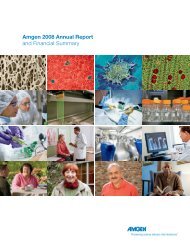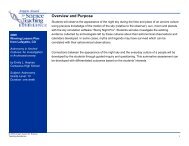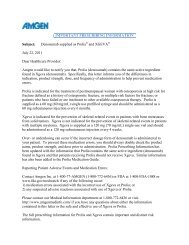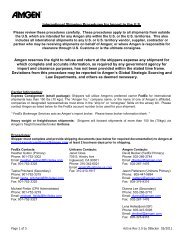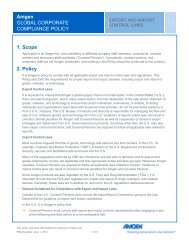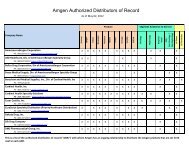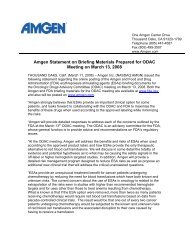Re: National Coverage Analysis for Erythropoiesis ... - Amgen
Re: National Coverage Analysis for Erythropoiesis ... - Amgen
Re: National Coverage Analysis for Erythropoiesis ... - Amgen
Create successful ePaper yourself
Turn your PDF publications into a flip-book with our unique Google optimized e-Paper software.
<strong>Amgen</strong> Comments on CAG-00413N<br />
July 16, 2010<br />
Page 10 of 15<br />
registration studies, are also identified in the EPOGEN ® (Epoetin alfa) label. Since the goal of<br />
therapy is to treat anemia in order to reduce the need <strong>for</strong> RBC transfusions and to improve<br />
patient reported symptoms and physical functioning, monitoring of hemoglobin levels is a valid<br />
surrogate <strong>for</strong> the goals of ESA therapy. This is understood by the nephrology community and is<br />
highlighted in their clinical practice guidelines <strong>for</strong> anemia management in CKD, which define<br />
treatment targets based on hemoglobin levels[36].<br />
B. Hemoglobin targets in <strong>Amgen</strong> RCTs Have Been Mischaracterized<br />
At the recent MEDCAC meeting and in several recent editorials, it was suggested that the lower<br />
target and placebo comparator arms in the NHCT and the TREAT studies, respectively, should<br />
be used to provide dosing guidance and hemoglobin target recommendations. These<br />
statements do not reflect the actual design of these <strong>Amgen</strong>-designed and executed studies.<br />
NHCT was a study of dialysis patients with pre-existing heart failure or ischemic heart disease<br />
comparing treatment with Epoetin alfa to a hemoglobin target of 14 g/dL (± 1 g/dL) to treatment<br />
with Epoetin alfa to a hemoglobin target of 10 g/dL (± 1 g/dL) on the risk of non-fatal CV<br />
morbidity and mortality. In this study, the protocol instructed investigators to target either 14 or<br />
10 g/dL, respectively. At enrollment, hemoglobin levels were between 9 and 11 g/dL. TREAT<br />
was a randomized, double-blind, placebo-controlled study of anemic CKD patients not on<br />
dialysis with diabetes comparing treatment with darbepoetin alfa to a hemoglobin target of 13<br />
g/dL versus treatment with placebo (with rescue darbepoetin alfa treatment when the<br />
hemoglobin level dropped below 9 g/dL) on the risk of cardiovascular events, death or<br />
progression to ESRD. There was no hemoglobin target in the placebo arm. At enrollment,<br />
patients had a hemoglobin level < 11 g/dL.<br />
C. Appropriate Characterization of Incidence of Stroke in Previous RCTs<br />
Given the concerns regarding the risk of stroke identified in TREAT, greater focus is now being<br />
placed on the occurrence of stroke in previous clinical trials including the NHCT study. In<br />
recently published editorials and at the MEDCAC meeting, the stroke risk in NHCT has been<br />
incorrectly cited as being as high as 39% vs. 29% in the higher and lower arms of NHCT<br />
respectively. According to the study report[17] the cerebrovascular accident event rates in the<br />
NHCT study, were similar in the high and low hemoglobin arms: 7% and 6%, respectively.<br />
D. Characterization of the Disease State and ESA Utilization Should be Based on<br />
Medically Accepted Definitions<br />
The Kidney Disease Outcomes Quality Initiative (KDOQI ) definition of CKD requires that<br />
kidney disease persist <strong>for</strong> ≥ 3 months. At the recent MEDCAC meeting, an analysis of ESA<br />
utilization using Medicare data defined “CKD” as two ICD-9 diagnoses of CKD within a 3-month<br />
window and “intermittent CKD” as having only a single diagnosis of CKD within a 3-month



